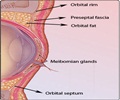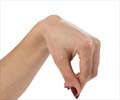- What are Chalazia and Styes? - (https://www.aao.org/eye-health/diseases/what-are-chalazia-styes)
- About Chalazion - (https://www.ncbi.nlm.nih.gov/books/nbk499889/)
- Chalazion - Overview - (https://medlineplus.gov/ency/article/001006.htm)
- Chalazion and Stye - (https://www.umkelloggeye.org/conditions-treatments/chalazion-stye)
- Chalazion - American Optometric Association (AOA) - (https://www.aoa.org/patients-and-public/eye-and-vision-problems/glossary-of-eye-and-vision-conditions/chalazion?sso=y)
- Chalazion - Wikipedia - (https://en.wikipedia.org/wiki/Chalazion)
- Chalazion - American Association for Pediatric Ophthalmology & Strabismus - (https://aapos.org/glossary/chalazion)
What is a Chalazion?
A chalazion is an eyelid condition, which is often mistaken for a stye (inflamed oil gland on the eyelid caused by bacterial infection). It manifests as a small cyst or bump on the upper or sometimes the lower eyelid. A chalazion is much smaller than a stye in most cases, and usually does not cause much pain.(1✔ ✔Trusted Source
What are Chalazia and Styes?
Go to source)
A chalazion is not a tumor and does not cause permanent changes to vision. It is more prevalent among adults in the age group of 30 to 50 years of age, although it can also affect children and older adults. A chalazion is also referred to as meibomian cyst, tarsal cyst, or conjunctival granuloma.
What are Meibomian Glands?
Eyelid glands are known as meibomian or palpebral glands. There are around 30 to 40 eyelid glands in each of the upper and lower lids of the eyes. Meibomian glands produce a thick liquid secretion known as sebum that is discharged through the tear film of the eye. Sebum is a mixture of oil and mucus and maintains lubrication of the surface of the eye.(2✔ ✔Trusted Source
About Chalazion
Go to source)
What are the Causes of Chalazion?
A chalazion occurs because of blockage of a meibomian gland. Such blockages may occur when the oil becomes too thick to drain through the opening of the gland, or if the opening itself has narrowed. This results in a buildup of oil within the gland, causing its enlargement. The gland may burst and cause inflammation of the surrounding tissue.
Failure to maintain proper hygiene, such as touching the eyes with unclean hands, can increase the risk of chalazion. People with oily skin are prone to developing chalazia. Individuals who have had a chalazion before are more likely to suffer from the condition again. The risk factors for chalazion development include:
- Chronic blepharitis - inflammation of the eyelids
- Acne Rosacea (acne-like skin condition)
- Seborrhea - skin problem that causes red, itchy rash and white scales(3✔ ✔Trusted Source
Chalazion - American Optometric Association (AOA)
Go to source)
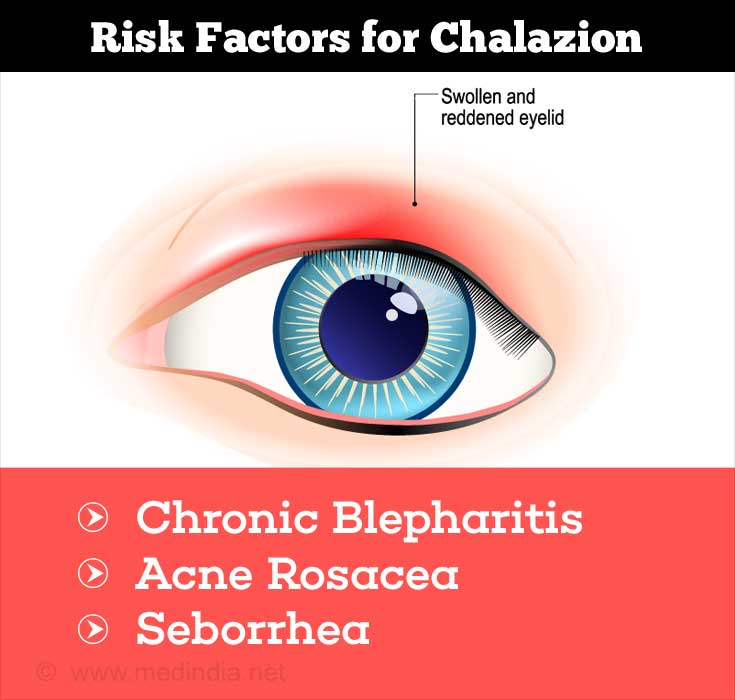
What are the Symptoms and Signs of Chalazion?
A chalazion can easily be mistaken for a stye, but the symptoms are not hard to identify. Common signs and symptoms of chalazion include the following:
- Sensitivity to light
- After a few days, the pain recedes and a lump or bump slowly starts to appear
- The lump may at first be barely noticeable, but could grow to be pea-sized
- Tearing of the eye is not uncommon
- The patient may experience drooping of the eyelid or blurring of vision, if the chalazion is large and exerts pressure on the eyeball
- Redness, inflammation, and tenderness of the eyelid
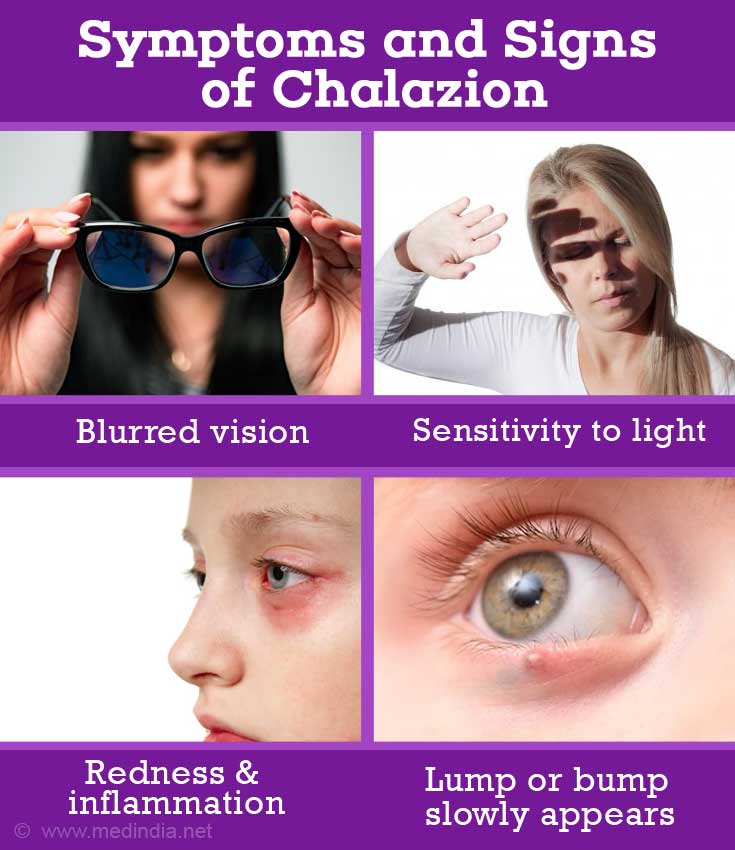
In most cases, the condition is non-threatening and disappear without any intervention. Without treatment, the symptoms usually last for a few weeks to a month. Although usually not a cause for worry, it is best to consult an ophthalmologist to avoid any complications.(4✔ ✔Trusted Source
Chalazion - Overview
Go to source, 5✔ ✔Trusted Source
Chalazion and Stye
Go to source)
How to Diagnose Chalazion?
Chalazion is diagnosed through history and examination of the eye. Your doctor will check the eyelid structure, skin condition, and appearance of the lashes. A bright light and magnification device are used to check the state of the oil gland openings and base of the eyelashes.
How do you Treat Chalazion?
A chalazion will often require minimal or no medical treatment at all, and may resolve within a few weeks. To relieve the condition and facilitate healing, you can try the following home treatments. Always consult with your doctor before following any home treatment.
- Apply warm compresses to the affected eyelid for periods of around ten to fifteen minutes. Do this at least four times a day until symptoms disappear. This can help to loosen up oil that has hardened and blocked the ducts, thereby easing drainage and facilitating healing.
- Massage the area gently several times in the day, preferably after applying a warm compress. This can further help to promote drainage.
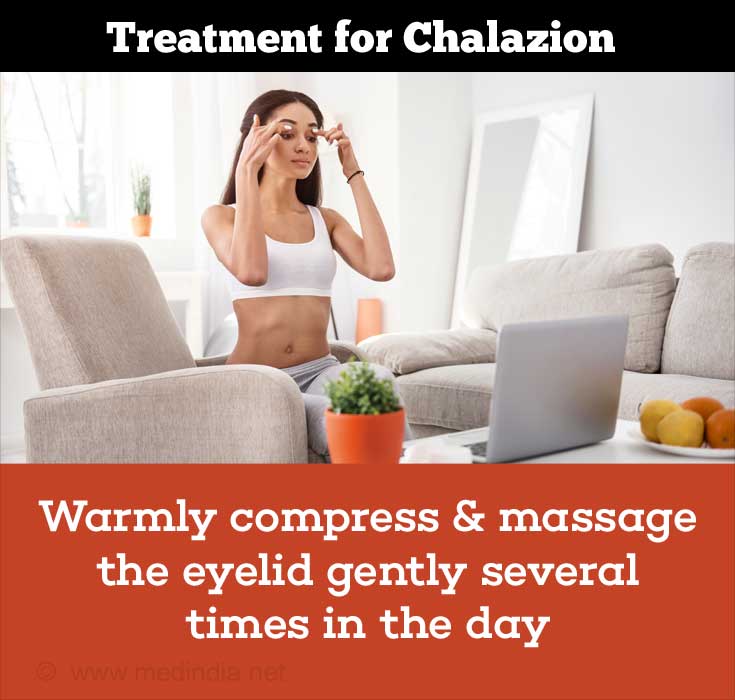
- If there is any discharge, clean the area and avoid touching your eyes.
In case the condition does not resolve with home treatment, make it a point to seek medical care. Your health care provider may prescribe antibiotic or steroid drops to treat the chalazion and could also administer injections. In some cases, surgical drainage may be necessary.
Frequent recurrences are problematic for some individuals and this can necessitate continued medication. A biopsy may also be recommended in cases where chalazion recurs at the same site, as this could, at times, suggest a more serious problem.(6✔ ✔Trusted Source
Chalazion - Wikipedia
Go to source)
How to Prevent Chalazion?
Chalazia cannot always be prevented, especially if you are susceptible to them, but there are certain steps you can take to minimize the risk of occurrence. The most important precaution is to always maintain high levels of hygiene, by keeping your face and eyelids clean and by avoiding touching your eyelids, without first washing your hands thoroughly.
If you are prone to chalazia, do keep the eyelids clean and prevent the buildup of dirt and oil, gently scrub the edge of the eyelids each night, before going to bed. You can use diluted baby shampoo to do this.(7✔ ✔Trusted Source
Chalazion - American Association for Pediatric Ophthalmology & Strabismus
Go to source)
Health Tips
- Never attempt to scratch at or ‘pop’ the cyst with your finger nails or any other object. This can worsen the problem and cause infections or other complications.
- If there is sudden
swelling of the entire eyelid , contact your health care provider. - Do not panic if there is swelling and bruising for as long as a week after undergoing surgical drainage, as this is normal.
- After surgical treatment you must avoid swimming for up to 2 weeks.
- Pat dry the eyelid after a bath, instead of rubbing vigorously.



